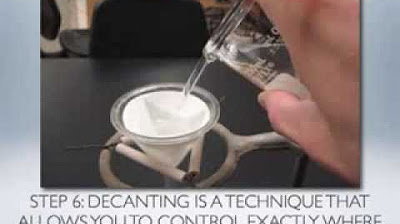Basic Laboratory Techniques - MeitY OLabs
Summary
TLDRThis video covers basic laboratory techniques using a Bunsen burner. It explains how to produce luminous and non-luminous flames, bend and cut glass tubes, and draw glass jets. The tutorial also demonstrates the creation of a wash bottle and the process of boring a cork, including softening it in water and fitting glass tubes into the bore. Each step is clearly outlined, providing a practical guide for students or professionals working in a laboratory setting.
Takeaways
- 🔥 A Bunsen burner is used for producing a non-luminous flame by opening the air hole, and a luminous flame by closing it.
- ⚡ A spark lighter is required to ignite the Bunsen burner once the gas is turned on.
- 🧪 When bending a glass tube, it must be heated in a non-luminous flame until soft and then gently pressed onto a tile to make it coplanar.
- 🔪 A glass tube can be cut by making a deep scratch with a triangular file, then using pressure to snap it cleanly along the scratch.
- 🧬 To draw a glass jet, the tube is heated, softened, and stretched until the middle portion is thin, then cut with a file.
- 💧 A wash bottle can be created using a 500ml flask and corks with bores, allowing for controlled streams of water through angled tubes.
- 🛠️ Corks are softened by dipping them in water and pressing them, making them easier to bore for fitting tubes.
- 🌀 When fitting a glass tube into a bored cork, wet the tube end with water and rotate it into the cork for a smooth fit.
- 🎯 To bore a cork, mark the spot, twist a borer into the cork while applying downward force, creating a clean hole from end to end.
- 🛁 The ends of glass jets can be rounded by heating them gently in a flame for a short period, ensuring smooth edges.
Q & A
What is the purpose of the Bunsen burner in the described experiments?
-The Bunsen burner is used to produce a flame that can be adjusted to either a luminous or non-luminous state for various laboratory tasks, such as bending or cutting glass tubes.
How can you produce a luminous flame with a Bunsen burner?
-A luminous flame is produced by closing the air hole of the Bunsen burner using the air adjusting disc.
What is the process of bending a glass tube?
-To bend a glass tube, heat it over the non-luminous flame while rotating it until it softens. Then apply gentle pressure so that the tube bends by itself, place it on a glazed tile, and press it gently to make it coplanar before allowing it to cool.
What materials are required for bending a glass tube?
-The materials required are a Bunsen burner, a glass tube, and a glazed tile.
How do you safely cut a glass tube?
-To cut a glass tube, scratch it deeply with a triangular file, then place your thumbs on each side of the scratch and apply pressure with a quick bending motion until it breaks smoothly.
What is the process of drawing a glass jet?
-To draw a glass jet, heat a glass tube in a flame until it softens, then gently pull the two ends in opposite directions to thin the middle section. Once cooled, scratch the narrow part with a triangular file and snap it with a quick bending motion.
What is the purpose of a wash bottle in the laboratory, and how is it made?
-A wash bottle is used to produce a stream of water. It is made by filling a 500ml flat-bottom flask with distilled water, inserting two bent tubes through a cork, and blowing air through the tubes to release the water.
How do you soften a cork for boring?
-To soften a cork, dip it in water, wrap it in filter paper, and then press it in a cork-presser until it becomes flexible.
What are the steps to bore a hole in a cork?
-First, mark the position of the hole on the cork, then place a borer on the mark, apply downward force while twisting it, and bore the cork from one end to the other.
How do you insert a glass tube into a bored cork?
-Wet the end of the glass tube, dip the bored cork in water, and insert the tube by rotating it gently to fit the tube securely into the hole.
Outlines

Dieser Bereich ist nur für Premium-Benutzer verfügbar. Bitte führen Sie ein Upgrade durch, um auf diesen Abschnitt zuzugreifen.
Upgrade durchführenMindmap

Dieser Bereich ist nur für Premium-Benutzer verfügbar. Bitte führen Sie ein Upgrade durch, um auf diesen Abschnitt zuzugreifen.
Upgrade durchführenKeywords

Dieser Bereich ist nur für Premium-Benutzer verfügbar. Bitte führen Sie ein Upgrade durch, um auf diesen Abschnitt zuzugreifen.
Upgrade durchführenHighlights

Dieser Bereich ist nur für Premium-Benutzer verfügbar. Bitte führen Sie ein Upgrade durch, um auf diesen Abschnitt zuzugreifen.
Upgrade durchführenTranscripts

Dieser Bereich ist nur für Premium-Benutzer verfügbar. Bitte führen Sie ein Upgrade durch, um auf diesen Abschnitt zuzugreifen.
Upgrade durchführen5.0 / 5 (0 votes)






